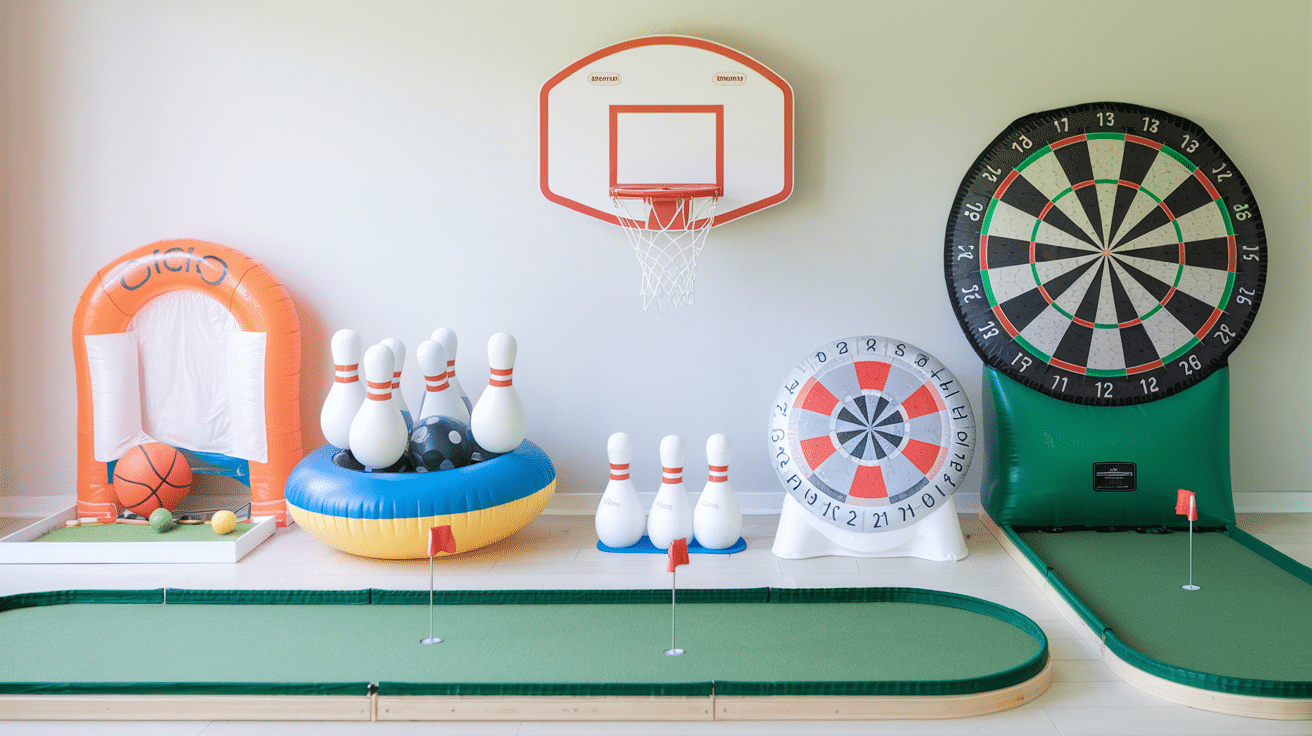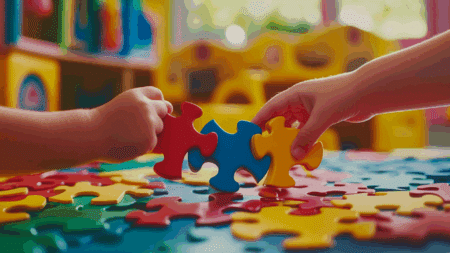Look, we’ve all been there. The kids are bouncing off the walls, it’s pouring outside, and everyone’s about five minutes away from a total meltdown.
But here’s the thing: indoor time doesn’t have to mean screen time. With a little creativity and some basic equipment, parents can change their living rooms into mini sports arenas that’ll keep the little ones active and entertained for hours.
From inflatable bowling sets that won’t damage furniture to electronic basketball hoops that track scores, 2025’s lineup of indoor sports games is seriously impressive.
And the best part? These games aren’t just fun; they’re helping kids develop coordination, teamwork, and healthy habits without them even realizing it.
Most Popular Indoor Sports Games
Indoor sports games keep kids active regardless of the weather. These games develop coordination, teamwork, and healthy competition while burning energy.
From mini basketball to inflatable bowling, these activities change living spaces into fun zones that entertain kids for hours without screen time.
1. Mini Basketball Hoop

This scaled-down version of basketball typically mounts on doors or walls and comes with a soft foam ball. Kids can practice shooting, play one-on-one, or create their own games like HORSE.
It’s perfect for developing hand-eye coordination and provides endless entertainment without needing much space. The soft materials mean no worries about broken windows or knocked-over lamps.
- People: 1-4 players
- Duration: 15-30 minutes
2. Inflatable Bowling Set

These lightweight, noise-free bowling sets feature inflatable pins and balls that won’t damage furniture or floors.
Kids can set up lanes in hallways or living rooms, keeping score just like at a real bowling alley. The game teaches basic math skills through scoring and helps with coordination. When playtime’s over, everything deflates for easy storage.
- People: 1-6 players
- Duration: 20-40 minutes
3. Indoor Putting Green

These compact artificial turf mats simulate a golf green with various difficulty levels and obstacles. Some models include automatic ball returns or electronic scoring. Kids learn patience and precision while developing fine motor control.
It’s a surprisingly meditative activity that can keep children focused for extended periods, and parents might find themselves joining in, too.
- People: 1-4 players
- Duration: 15-45 minutes
4. Table Tennis Set

Also known as ping pong, portable table tennis sets can transform any table into a gaming surface. Players use lightweight paddles to hit a small ball back and forth across a mini-net.
The game develops lightning-fast reflexes, hand-eye coordination, and strategic thinking. Advanced sets include foldable tables, but simpler versions just need a dining table and a portable net.
- People: 2-4 players
- Duration: 20-60 minutes
5. Velcro Dart Board

A safer alternative to traditional darts, these boards use soft balls or discs with velcro that stick to the fabric target. Kids can play classic dart games like 301 or create their own variations.
The game improves aim and teaches basic addition and subtraction through scoring. The soft materials mean no sharp objects or wall damage.
- People: 1-4 players
- Duration: 15-30 minutes
6. Indoor Cornhole

This popular tailgate game translates perfectly to indoor play with smaller, lightweight bean bags and portable boards.
Players take turns trying to toss bags into holes in the target boards. The game is easy to learn but challenging to master, making it perfect for mixed-age groups. It naturally teaches turn-taking and good sportsmanship.
- People: 2-8 players
- Duration: 30-45 minutes
7. Indoor Disc Golf

This miniature version of disc golf uses soft fabric discs and household items as targets. Kids create courses through different rooms, aiming to hit targets in the fewest throws possible.
It combines precision with strategy as they move around furniture and plan their shots. The game naturally adjusts to different skill levels as players create easier or more challenging courses.
- People: 1-6 players
- Duration: 20-40 minutes
8. Floor Hockey Set

These sets include plastic sticks, a soft puck or ball, and portable goals for indoor play. Kids can set up matches in basements, garages, or living rooms with furniture pushed aside. The game develops teamwork, coordination, and cardiovascular fitness.
Soft materials make it safe for indoor play, though parents might want to establish some “no slap shot” rules.
- People: 2-6 players
- Duration: 30-60 minutes
9. Indoor Volleyball Set

Using a lightweight, soft ball and a portable net that can be set up between furniture or in hallways, indoor volleyball brings this popular team sport home.
The rules can be simplified for younger players, and the soft ball means no worries about broken items. This game is excellent for developing teamwork and communication skills while providing a full-body workout.
- People: 4-8 players
- Duration: 20-45 minutes
Indoor Sports to Tickle Your Kid’s Brain

Not all indoor sports games are just about physical activity; many actually give kids’ brains a serious workout, too. These games blend fun with cognitive development, helping children build problem-solving skills, strategic thinking, and mental agility without feeling like they’re doing homework.
10. Chess Boxing
Kids alternate between one-minute chess moves and one-minute gentle boxing with soft gloves. This unique combo develops focus, strategic thinking, and context-switching abilities while burning energy and teaching impulse control.
11. Strategy Board Games with Movement
Kids become the game pieces in “Twister Chess” or “Physical Checkers,” moving across floor mats. These games build spatial awareness and planning skills while incorporating physical activity to keep energy levels balanced.
12. Memory Relay Races
Kids memorize patterns, words, or images at one station before racing to another to replicate them. This activity boosts working memory and recall abilities while adding the excitement of physical movement.
13. Reaction Ball Drills
Using a bumpy rubber ball that bounces unpredictably, kids must quickly react to random patterns. This improves neural processing speed, hand-eye coordination, and adaptive thinking skills in a fast-paced challenge.
14. Indoor Orienteering
A treasure hunt with clues requiring math, puzzles, or logic challenges to find each station. Kids navigate through the house using brain teasers as their map, blending problem-solving skills with physical activity.
15. Balance Board Puzzles
Kids solve puzzles or math problems while balancing on a wobble board. This challenges them to maintain physical stability while engaging their brain, strengthening mind-body connections, and improving concentration simultaneously.
16. Speed Stacking with Math
Kids solve a math problem between each cup stacking sequence. This combines rapid fine motor movements with mathematical thinking, easily adaptable for different ages by adjusting math difficulty levels.
The Best Indoor Sports Games for Kids with Special Needs

Indoor sports provide valuable opportunities for children with special needs to develop motor skills, social interaction, and sensory regulation in a controlled environment. The right games create inclusive experiences that celebrate each child’s unique capabilities while supporting their developmental expendition.
17. Balloon Volleyball
Using a balloon instead of a traditional ball slows down the game, giving kids more reaction time.
This adaptation helps children with processing delays or motor coordination challenges experience success while still developing hand-eye coordination and cooperative play skills.
- Modification tip: Use colorful balloons for visual tracking
- Skill building: Social turn-taking and bilateral coordination
- Best for: Processing delays, ADHD, dyspraxia
18. Seated Bowling
This modified version uses lightweight pins and balls that can be rolled from a seated position. It’s perfect for children with mobility challenges, providing accessible success while building upper body strength, directional awareness, and cause-effect understanding.
- Modification tip: Use textured balls for sensory input
- Skill building: Visual tracking and spatial awareness
- Best for: Mobility challenges, cerebral palsy, muscular dystrophy
19. Sensory Obstacle Course
A customizable indoor course with various textures, sounds, and movements that addresses specific sensory needs. This activity helps children with sensory processing disorders develop body awareness, motor planning, and sensory integration in a fun, non-threatening environment.
- Modification tip: Create visual start/stop markers for clear boundaries
- Skill building: Vestibular processing and motor sequencing
- Best for: Sensory processing disorder, autism spectrum disorder
20. Target Bean Bag Toss
Using textured bean bags and targets with different sound effects when hit, this game engages multiple senses.
Children with autism spectrum disorder often benefit from the predictable structure and immediate sensory feedback while practicing motor planning and social turn-taking.
- Modification tip: Use color-coded targets for visual organization
- Skill building: Proprioceptive awareness and hand-eye coordination
- Best for: Autism spectrum disorder, developmental coordination disorder
21. Adapted Floor Hockey
Using pool noodles as sticks and a large, slow-moving foam puck makes this game accessible.
Children with developmental disabilities can participate in team play while developing gross motor coordination, spatial awareness, and cooperative interaction at their own pace.
- Modification tip: Create larger goals for increased success
- Skill building: Bilateral coordination and motor planning
- Best for: Down syndrome, developmental delays, mild cerebral palsy
22. Musical Movement Freeze Game
This rhythm-based activity with visual cues alongside music supports children with hearing impairments. The game helps develop auditory processing, body control, and motor planning while creating opportunities for joyful self-expression and social engagement.
- Modification tip: Add floor vibrations for sensory feedback
- Skill building: Auditory processing and impulse control
- Best for: Hearing impairments, auditory processing disorder
23. Balloon Badminton
Using lightweight racquets and balloons instead of shuttlecocks makes this game accessible and success-oriented. Children with attention deficit or fine motor challenges can track the slow-moving balloon while developing hand-eye coordination and sustained focus.
- Modification tip: Use paddle grip adaptations for easier handling
- Skill building: Visual tracking and timing skills
- Best for: Fine motor challenges, visual impairments, attention deficits
Tips to Make Your Kid’s Next Playdate Fun
Hosting a successful playdate doesn’t necessarily have to be complicated or expensive.
With a few indoor sports games ready to go and some simple preparation, parents can create memorable experiences that keep kids engaged and happy while building important social connections.
- Rotate through several short activities – Kids’ attention spans vary, so plan to switch games every 15-20 minutes to keep the energy high and prevent boredom.
- Create simple prizes or achievements – Small rewards like stickers or a special snack for participation (not just winning) make games more exciting without fostering unhealthy competition.
- Prepare for different energy levels – Have both high-energy games (like floor hockey) and calmer activities (like table tennis) ready to balance excitement with focused play.
- Include cooperative and competitive options – Mix games where kids work together toward a common goal with friendly competitions to develop different social skills.
- Keep snacks and water accessible – Active play builds appetites, so have healthy, easy-to-grab options available that won’t interrupt the flow of games.
- Have a backup plan for shy kids – Some children need time to warm up, so prepare a parallel activity that lets them ease into social play at their own pace.
To Conclude
Indoor sports aren’t just a rainy-day backup plan; they’re valuable tools for development that deserve a permanent place in every family’s routine.
Whether boosting brain power, building physical skills, or creating inclusive experiences for children with special needs, these activities deliver benefits that extend far beyond simple entertainment.
Many require minimal investment and setup time. As screens continue competing for kids’ attention, these tactile, engaging games provide a welcome alternative that brings families together. So clear some space, gather the kids, and get moving!
The laughter, learning, and memories created through these indoor activities might just become some of your child’s most treasured childhood experiences, no matter what the weather is doing outside.




